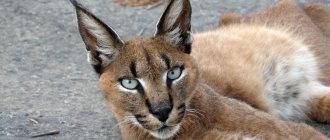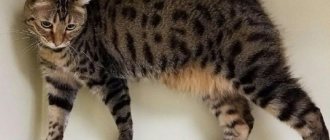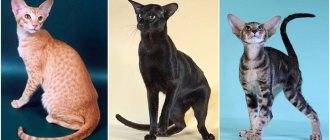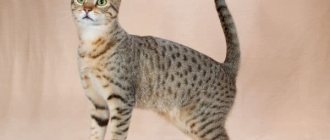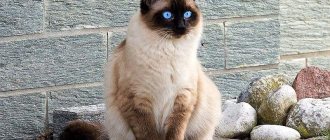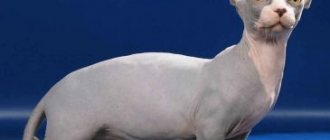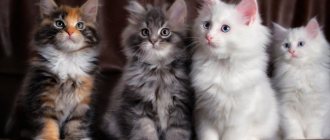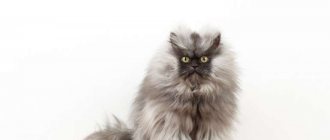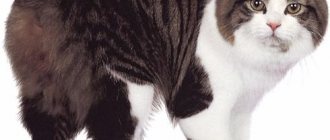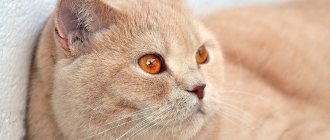Caracal
This beauty is kept at home
The average family does not keep caracals. The reason is the high cost of such a kitten: the cost starts at 450 thousand rubles.
Caracal is a native of Turkey. At least the country is considered the homeland of the animal. Over time, the wild cat spread to Africa, Arabia, India, etc.
Nowadays, wealthy people can afford to own a caracal. An animal with tassels on its ears requires space; representatives of the species are mobile, freedom-loving and very characteristic.
Externally, the caracal resembles a lynx: reddish coat color, rather long body, high ears with tassels. By the way, young animals have tassels that stand up, while older caracals droop and droop.
Breeders and owners of wild cats say that their pets are highly trainable, quickly get used to people and choose only one owner from all family members.
Caraquet
Wild beauty, but domestic character
Please do not confuse caracal and caracat. The former are wild predators, the latter are crossbreeds between a caracal and an ordinary cat.
There are several versions of the origin of the breed. According to the first, Caraquets are an accidental breed from Russia. Allegedly, in the late 90s, a caracal cat living in the Moscow Zoo mated an ordinary cat who, God knows, looked into his enclosure. Murka gave birth to a baby who looked like her father: the same color, facial expression and tufts on the ears. It was with him that the creation of a new breed began.
The American version of the origin of the breed says: in 2005, a breeder of Abyssinian cats bred one of her pets to a caracal cat. The result was the Caraquet breed.
Caracat is a large animal with the appearance of wild ancestors. A distinctive feature of the breed is its huge eyes and ears, decorated with tassels. Despite the presence of caracals in the pedigree, the descendants turned out to be affectionate, attached to humans and very cute. Breeders say that the caracat is a cat with the habits of a dog.
What is special about these cats?
Brushes are not given by nature for beauty.
There are several versions of their appearance:
- They amplify sound waves, so a cat can even hear the rustle of a mouse at a very long distance.
- Cat breeds with tassels are descendants of the lynx, and for them these fluffy tips served as a beacon. One could easily see a fellow in the thickets.
- According to the third version, the tassels are something like the rings of an oak tree: the older and wiser the cat, the darker the hairs.
Maine Coon
American breed from Maine. Weighs up to 15 kg - the heaviest and largest cat in the world. They are excellent hunters, and they look great; cats have gained popularity for their qualities.
Coons have very interesting colors: fiery literally sparkles in the sun, charcoal is also not bad, but is sensitive to diet - something has changed, and the color of the coat will change.
We suggest you familiarize yourself with How to give an injection to a cat: intramuscularly, at the withers, thigh, leg, subcutaneously, video, how to give an injection to a cat or kitten at home
Some are afraid that these cats are aggressive. In fact, this is completely wrong! Maine Coons rarely defend themselves with their claws, do not show aggression, and are safe.
The older a cat gets, the more time he spends resting or sleeping. Good tree climbers, they love to climb higher and watch the flow of their master's life. Make sure that shelves and beds are durable and can withstand heavy weight.
They are not afraid of water at all, they know how to swim. They don't meow, but talk. They have a muscular body, a rectangular head and a wide chest.
Price per kitten: from 25,000 rubles.
The tassels are not as pronounced as those of Maine Coons. Cats look very bulky due to their dense fur, which traps heat. The body is strong, the fur does not allow water to pass through, which allows you to stay dry even in rainy weather.
The eyes are almond-shaped, the tail is very fluffy, the paws are strong, and there is a luxurious frill on the chest. Your pet will shed often, so malt paste and furminator are a must!
It is not recommended for people with allergies.
The character is peaceful, forest cats are patient even with particularly restless children, but they do not like hugs and squeezes. The best rest is on the sofa next to the owner, stretched out to his full height. They don’t take revenge; if something doesn’t suit them, they’d rather leave. It takes a lot of effort to get this charmer to let out her claws!
Price: 10,000 rubles.
Maine Coon
One of the largest breeds in the world
The breed is one of the largest in the world. It is not surprising, since the weight of an adult cat reaches 15 kg, and in combination with fluffy hair, tufts on the ears and a “brutal” facial expression, Maine Coons make an indelible impression.
Anyone who keeps representatives of this breed will not let you lie: “coons” are gorgeous! And we are not talking about the appearance of these animals at all, they also have an excellent character. With members of the family in which Maine Coons live, they are affectionate and talkative. Strangers are such an irritant; cats are wary of strangers. If a stranger who comes to the house for the first time decides to fraternize with its four-legged inhabitant, he risks getting a clawed paw on the hand, being scolded in cat language, or being bitten.
"Aborigines" from the Isle of Man
This is roughly the name given to the Manx cats that settled on the Isle of Man in the Irish Sea. How they got there is not known for certain, although there are many versions: from biblical to modern scientific.
Today there are 4 varieties of Manx. Depending on the length and shape of the tail, cats are divided into:
- Rampi (sacral). The tail is completely absent.
- Riser (growth). Instead of a tail, there is only a small protrusion on a couple of vertebrae. -9
- Stumpy (short). A small tail measuring 4-8 vertebrae.
- Longi (long). Quite a long tail, almost identical to the “classic” length.
- Rumpy
- Stumpy
- Riser
- Long
If we talk about character, animals are cheerful and energetic. They love active games, love to climb trees and have enviable jumping ability. The habits of cats are somewhat similar to dogs, in particular, this concerns learning various commands. Since Manx cats are very sociable, they are not recommended for people who are rarely at home.
Another distinctive feature of this breed is its excellent hunting qualities. Owners of such pets should be calm about the fact that prey in the form of mice, rats, moles and other garden and dacha “fauna” will be brought into the house. Manx cats will always find a common language with children, even when the baby is too persistent in showing his love and tormenting the cat with annoying caresses.
Short-tailed elf (Pixie-bob)
Terrible but cute elf
A hybrid of a forest cat and a domestic cat, the first mention of the breed appeared in the 80s of the last century in the USA. The breed was named after the first short-tailed kitten born as a result of mating a wild forest cat and an ordinary cat. The baby was named Pixie, which means “Elf”.
Elves look menacing: large body and head, frowning eyes, tufts on their ears - all this makes them look like their wild ancestors. In fact, pixie bobs are the kindest and most gentle creatures. Cats of this breed are much more attached to their owner than to other family members.
The peculiarity of the animals is not only their unusual exterior, but also the presence of extra toes on their paws. It is also extremely difficult for elves to get along with other cats, so it is recommended to have representatives of the breed as the only pet in the family.
Lynx-like felines that can live with humans
Lynxes are not the only representatives of the family with long hairs on their ears and camouflage coat color. Among wild relatives, caracals and jungle cats have the greatest external resemblance to the famous predator. They also live in the wild, but can live with humans. However, for their maintenance it is necessary to create conditions close to the natural environment.
Caracal - steppe lynx
The caracal is called the steppe lynx. Wild caracals are found in Africa, Central Asia, the Middle East, and in some areas of Turkmenistan, Kyrgyzstan, Uzbekistan and Dagestan.
Caracal
Caracals have a slimmer build and weigh 11–12 kg. The tall, straight ears have distinct, long dark hairs. The steppe lynx's fur is dense, short, and has hard bristles on its paws. A distinctive feature of the caracal is its reddish coat without spots. In addition, the animal has a fairly long tail, growing up to 30 cm.
Baby caracals
Kittens born in the wild will not be able to become pets. Only animals born from individuals kept in captivity can live with humans. It is better to keep domesticated caracals on the territory of country houses, where they will have the opportunity to move freely over a large area.
When keeping a caracal at home, special attention should be paid to nutrition. A predator's diet must include raw meat, poultry, and eggs.
Some owners of these exotic pets feed them premium or super-premium dry ready-made food.
It is not recommended to have caracals in a house where there are small children.
A predator has very strong natural instincts, so if handled carelessly, it can quickly hit back at the offender.
Jungle cat - marsh lynx
People were able to tame the jungle cat 3 thousand years ago. The people of Egypt were the first to do this. They called it house, which meant "house", because the animals lived in people's houses. Another nickname for the animal is the swamp lynx. These animals do not like to go out into open areas. They live in reed thickets, among bushes growing on the banks of water bodies, and often hunt for fish and waterfowl. Animals visit human settlements only when there is a lack of food. They raid chicken coops.
jungle cat
Populations of these predators are mainly found in regions with warm climates. They live in Africa, Central Asia, the Caucasus, and also live in India, Palestine, and Thailand. In Russia, animals can be seen on the Volga coast and in Dagestan.
This predator is similar to a lynx in the color of its coat, but is smaller in size. The body length of the jungle cat is about 90 cm, the weight of the largest individuals reaches 12 kg, the height at the withers does not exceed 0.5 m. Small spots on the body are almost invisible in adult individuals, they are more pronounced in kittens.
The jungle cat becomes a pet only in exceptional cases. Developed natural instincts make it dangerous even for the owner who has lived nearby since childhood.
You can keep a swamp lynx in an area where it can freely hunt, swim and walk. The proximity of other pets to a wild cat is unacceptable.
Norwegian Forest Cat
Feline perfection
A beauty originally from the Norwegian forests, who miraculously became an ordinary cat. According to ancient legend, guardians lived in the forests of Norway. No one had ever seen them, because the guardians moved between the trees at the speed of light. One day one of the guardians of the forest hesitated and his large, fluffy tail flashed between the trees. People saw this and immediately began vigorous activity to capture the forest guardian.
The guardians turned out to be beautiful cats. Huge, fluffy, with expressive eyes and tufts on the ears. The animals, at first, resisted, completely unwilling to be tamed. But time passed, cats learned to trust people, and the latter declared forest guardians as a new breed. This is how the Norwegian Forest Cat appeared.
Representatives of the breed are large (up to 9 kg), energetic and self-sufficient. Being hunters by nature, “Norwegians” do not get along well with other domestic animals. Especially with birds and rodents. Small breeds of dogs are regarded by Norwegian forest cats as a misunderstanding, not worthy of attention. Forest beauties tolerate their own kind, but with difficulty. It is better to have a Norwegian Forest Cat as your only pet.
Cat breeds with abnormal ear structure
There are eight breeds of cats in which the structure of the ears differs from the usual standard shape. These breeds include:
- Scottish fold. Today this breed is the most common. It was developed in the 20th century in Scotland. The appearance of cats is quite unusual; they resemble small owlets due to their curled ears and large eyes. Due to a mutation, Scottish cats have two types of ears: forward-curved (called Scottish Folds) and straight (Scottish Straights). For many years, geneticists prohibited the breeding of this breed due to the accompanying health problems, but the problem was solved. During breeding, Scottish Folds were crossed only with Scottish Straights. As a result of such mixing, the gene for lop ears remained, and hereditary diseases disappeared.
- Highlander is a cat breed bred in America in the nineties of the twentieth century. Breeders crossed the jungle curl and the desert lynx. The result was a cat with a beautiful spotted color, a small tail and curled ears. This breed was officially recognized by the International Cat Association in May 2008. Fans of unusual breeds are happy to purchase Highlanders.
- The American Curl is a relatively new breed, originally from the USA. Pets have an interesting ear structure; they curl outward. It is noteworthy that kittens are born with straight ears, but after a week they begin to curl up. The American Curl was recognized only in 1983. At the same time, standards for this breed and a breeding plan were developed. In the late 90s, Roy Robinson, a British breeder, wrote an article stating that, apart from curled ears, no genetic disorders were observed in bred Curl kittens. And unlike other breeds that take decades to be recognized, the American Curl has been accepted by the International Cat Association.
- Peterbald (St. Petersburg Sphynx) is a Russian breed, bred in 1994 by Olga Mironova. A Russian felinologist crossed an oriental cat and a Don Sphynx. The result was a hairless pet with big ears. The beautiful St. Petersburg Sphynx received recognition from the Breeding Felinological Federation in 1996. At the end of the twentieth century, Peterbald gained worldwide recognition. To date, crossbreeding work continues.
- Ukrainian Levkoy - the breed was bred in 2004 by felinologist E.V. Biryukova. She crossed the Don Sphynx with the Scottish Fold. In 2007, a nursery for Levkoys was opened in Russia. A distinctive feature of the breed is the appearance of the ears, which are located high and slightly curved towards the head. This breed is becoming increasingly popular in the modern world.
- The Elf is a breed native to North America. In 2006, this breed was developed by two breeders Kristen Lead and Karen Nelson. They crossed the Canadian Sphynx and the American Curl. The result was a beautiful hairless cat with large curved ears, like an elf. Hence the name. Pets have good health and endurance. Since selection work is still ongoing, the breed has not been officially recognized by any phenological organization.
- Oriental cats were bred by American breeders in the 60s. By crossing a Balinese cat and an Oriental shorthair, breeders were able to create this amazing cat. For the first time, the elegant beauty was presented at competitions in 1977 as an independent breed. But long-eared cats were officially recognized in 1997 by the GCCF association. The Oriental cat is similar to the Siamese breed, only its ears are much larger.
- Kinkalow - in 1997, American breeder Terry Harris crossed an American Curl with a Munchkin. As a result of this crossing, kittens were born with two different mutations - short legs and curved ears, a long tail and a massive body. In 2008, the Kinkaloo was recognized by the Dwarf Cat Association. Today, representatives of this breed can be seen mainly in America.
Each of the above breeds has its own advantages and disadvantages. But they all have one thing in common - the “wrong” structure of the ears. Some people are attracted and impressed by this feature, while others are repulsed. In any case, cats, despite their body structure, remain affectionate and gentle favorites for their owners.
